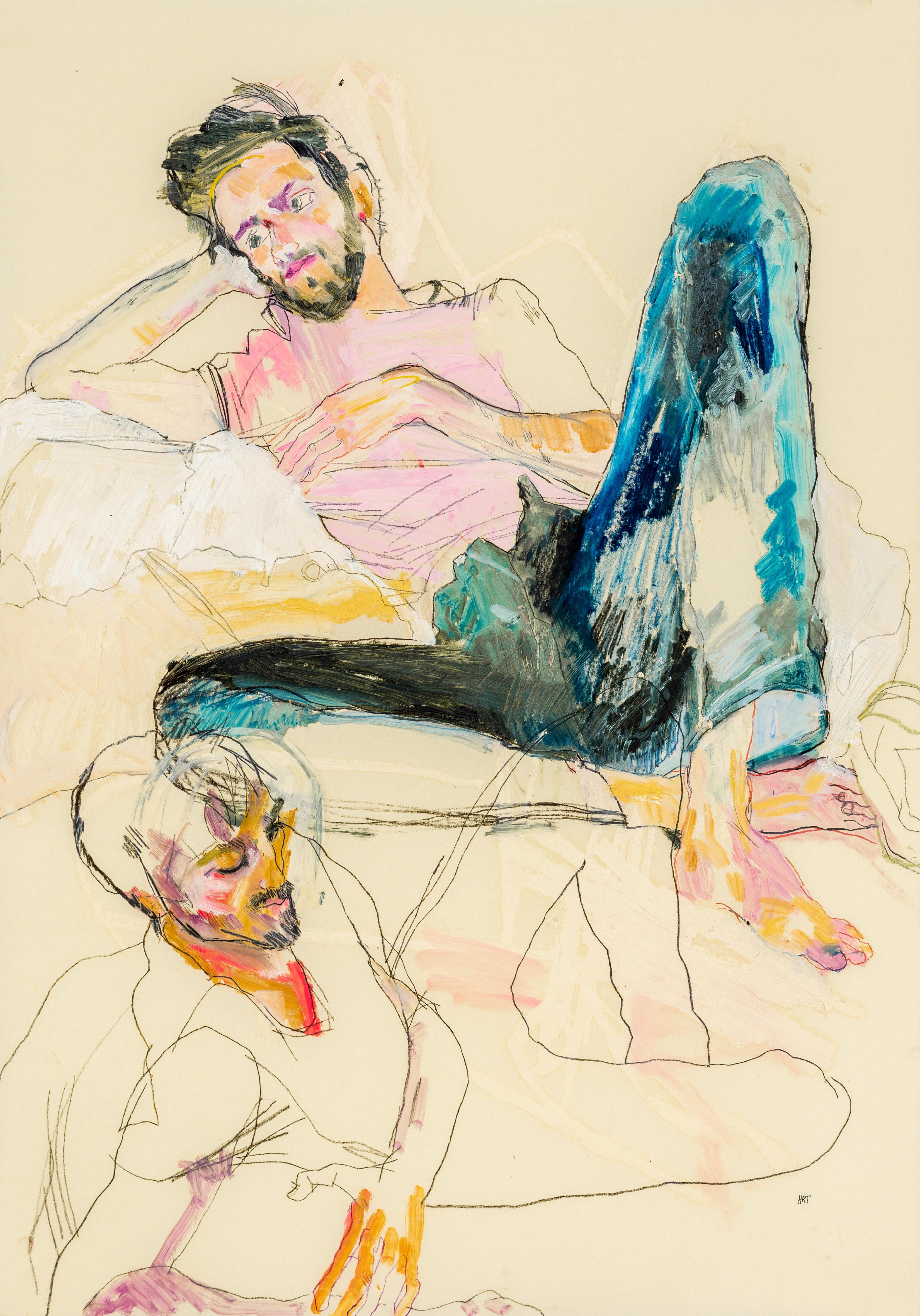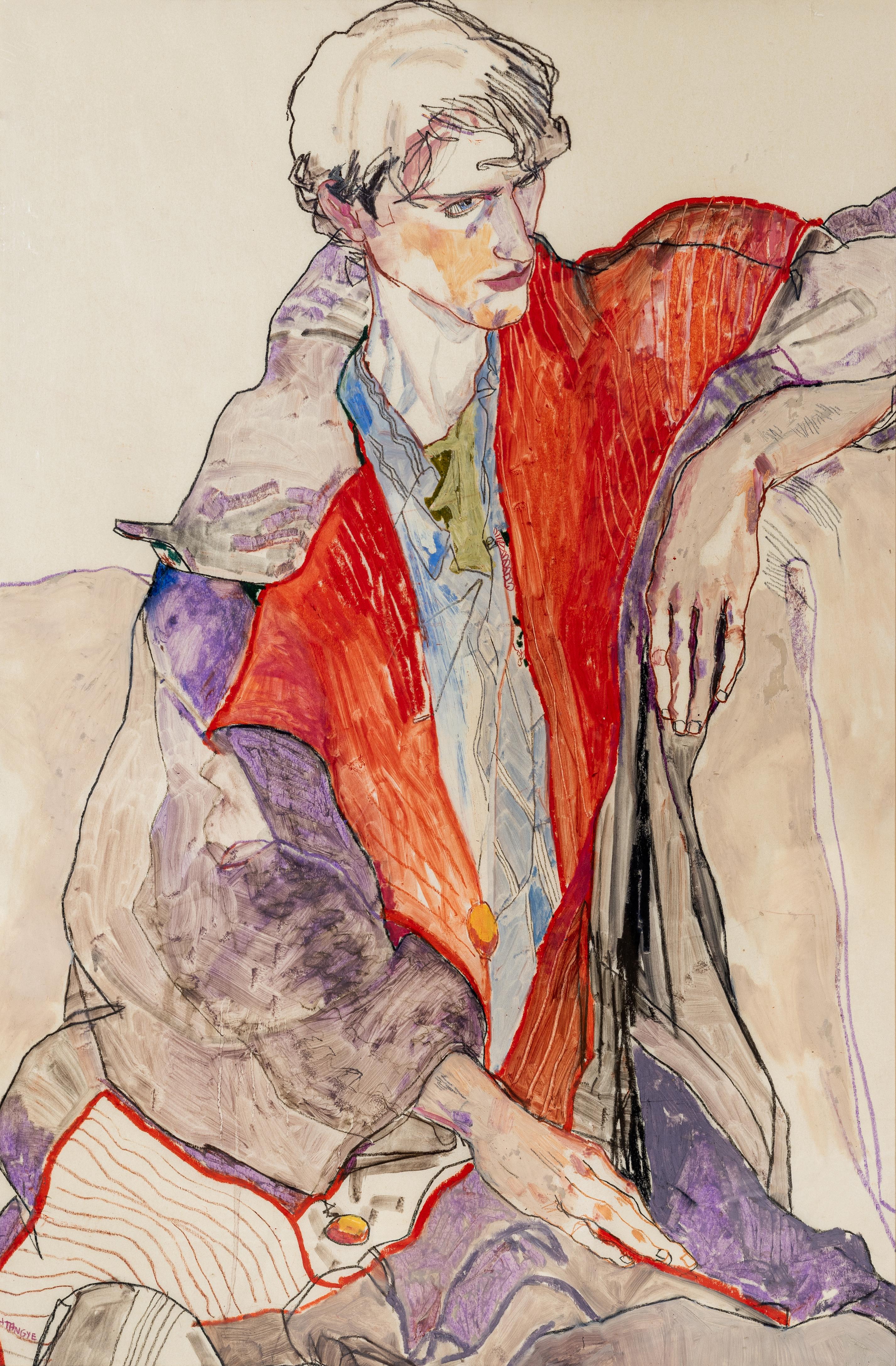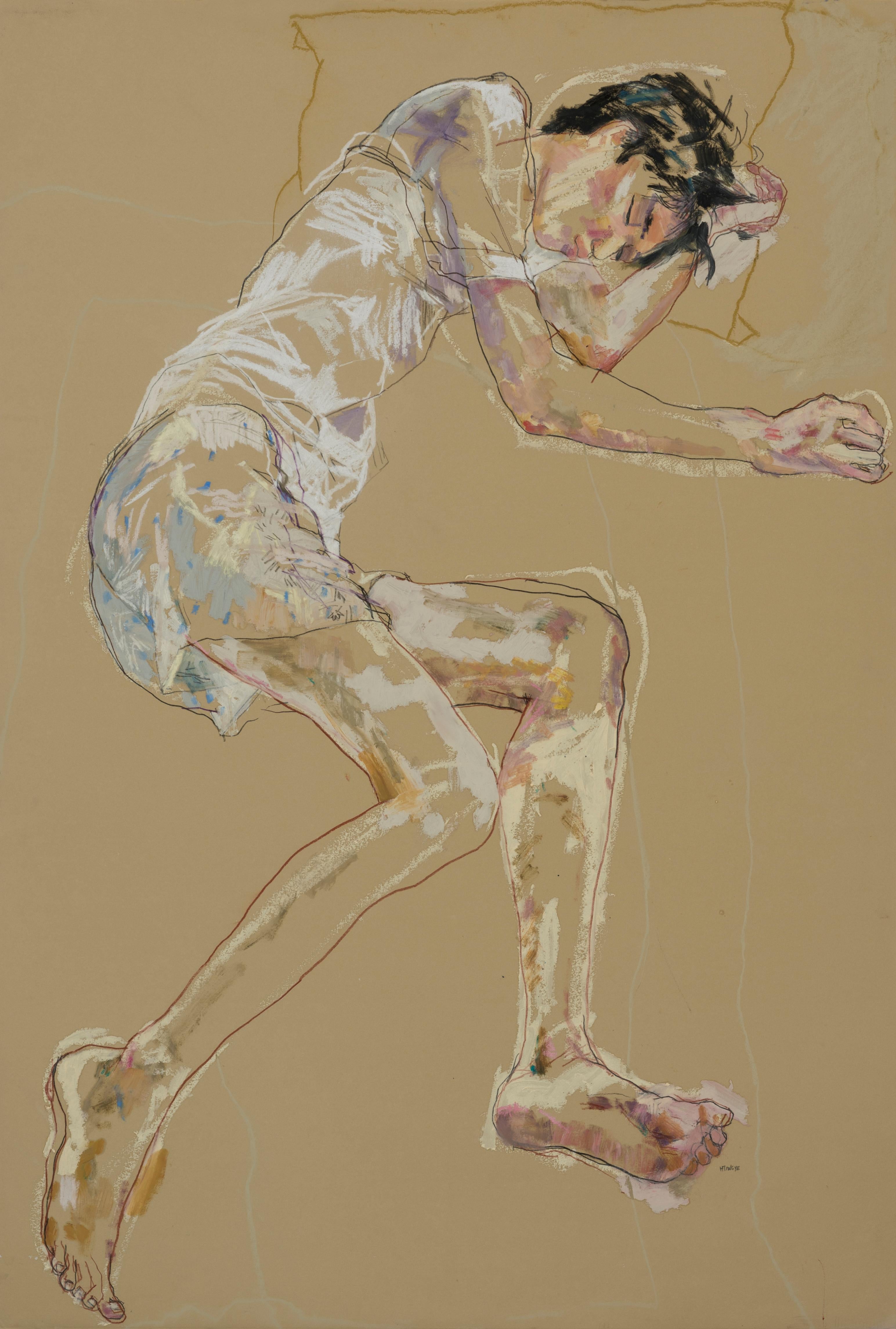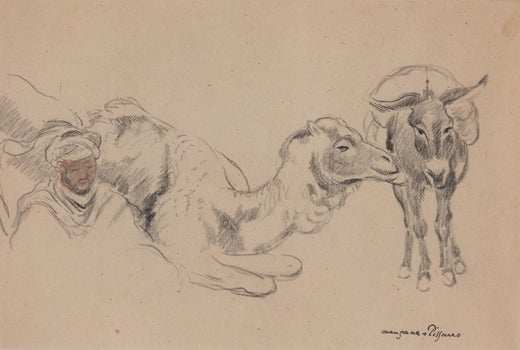Georges Henri Manzana PissarroRoboa Sleeping (The Artist's Wife) by Georges Manzana Pissarro - Drawingcirca 1940
circa 1940
About the Item
- Creator:Georges Henri Manzana Pissarro (French)
- Creation Year:circa 1940
- Dimensions:Height: 8.04 in (20.4 cm)Width: 12.29 in (31.2 cm)
- Medium:
- Period:
- Condition:
- Gallery Location:London, GB
- Reference Number:1stDibs: LU261213100452
Georges Henri Manzana Pissarro
Georges-Henri Pissarro, better known as Manzana, was born in Louveciennes, the third of Camille Pissarro and Julie Vellay’s seven children.
He studied with his father from a very early age and, like Lucien — Camille and Julie's eldest son — he spent his formative years surrounded by distinguished artists of the Impressionist movement, such as Monet, Cézanne, Renoir and Gauguin, all of whom frequented the Pissarro home. At his father's side he learned not only to handle brush and pencil but also to observe and to love nature.
Thus steeped in tradition and subjected to these diverse influences, Manzana turned out to be a prolific and versatile artist, producing work in oil, pastel and watercolour. As a young man he adopted his father's purely Impressionist style and produced a series of landscapes around Pontoise and Eragny. However, around 1906 he progressed beyond that and went in search of other means of expression via the design of furniture and decorative objects. The influence of Gauguin's exotic native scenes from Tahiti and Martinique certainly contributed to the development of Manzana's Orientalism, which at this time began to manifest itself in some of his paintings by his experimenting with gold, silver and copper paint.
Like all the second generation Pissarro artists, Georges initially worked under an assumed name. In 1894 he adopted "Manzana,” the family name of his maternal grandmother, and it was not until 1910, out of respect to his then-deceased father, that he employed his own family name when signing his work.
During the early 1900s Manzana regularly exhibited Impressionist works at the Salon d'Automne and the Salon des Indépendants, as well as Durand Ruel and Druet in Paris. In 1907 he had his first exhibition of decorative works at Vollard, but it was in 1914 that he had the most important exhibition of his career at the Musée des Arts Décoratifs, where he exhibited 311 works including tapestries, carpets, furniture, glassware, decorative paintings, etchings and lithographs.
Manzana continued to exhibit his work regularly until the late 1930s, splitting his time between Les Andelys and Paris, although spending several summers at Pont Aven in Brittany, where the local costume and lifestyle inspired a series of paintings in the 1930s. At the declaration of war in 1939, he moved with his family to Casablanca, where he stayed until 1947.
Manzana was married and widowed three times. He spent the last years of his life with Félix, his youngest son who was also an accomplished artist, in Menton, returning to the Impressionist tradition and painting the local landscape.
(Biography provided by Stern Pissarro Gallery)
- ShippingRetrieving quote...Ships From: London, United Kingdom
- Return PolicyA return for this item may be initiated within 7 days of delivery.
- Nu Assise by Ludovic-Rodo Pissarro - Nude drawingBy Ludovic-Rodo PissarroLocated in London, GBNu Assise by Ludovic-Rodo Pissarro (1878-1952) Charcoal on paper 31.3 x 24.2 cm (12 ⅜ x 9 ½ inches) Signed lower right, L.Rodo This work of art is accompanied by a certificate of authenticity signed and dated by Lélia Pissarro. Artist biography: Ludovic-Rodolphe Pissarro, born in Paris in 1878, was Camille Pissarro’s fourth son. Encouraged by his father, he began drawing from nature at an early age. He was familiarly known as “Rodo” and generally signed his works "Ludovic-Rodo", or early on in his career simply "Rodo". The impact of Camille’s art and teaching on Rodo was considerable. His artistic production encompassed a wide range of media, including oil painting, tempera, watercolour, gouache, wood engraving, drawing and lithography. Rodo exhibited regularly at the Salon des Indépendants over a forty-year period. In 1894, at the age of sixteen, Rodo published his first wood engravings in the anarchist journal, Le Père Peinard. When Camille left France for the safety of Belgium during the anarchist upheavals of the same year, Rodo joined him there. Rodo moved into his first studio in Montmartre with his brother Georges in 1898. Works of this early important period until just after the death of his father in 1903 were post-impressionist and clearly painted under the influence of his father. By 1904 living in Paris, he found the nightlife and the habitués of the cafes, theatres, circuses and cabarets compelling subjects for his work and changed dramatically the style of his painting, affiliating himself to the Fauve artists. Rodo became close to artists such as Kees Van Dongen, Maurice de Vlaminck and Raoul Dufy. In 1905 he participated in the first Fauve exhibition at the Salon des Indépendants. In 1907 he visited Van Dongen in Rotterdam and the two artists continued to paint together, something they often did in Paris. In 1914 he married, though he never had children. Later that year at the outbreak of the War Rodo moved to England. Over the next seven years he lived mainly in and around West London. He worked closely with his brother Lucien to establish in 1915 the Monarro Group, formed with the aim of exhibiting work by contemporary artists inspired by Impressionism. Many of the works produced by Rodo while he was in England were of London landmarks but, he was also interested in the urbanisation of West London. After 1921, when Rodo had already returned to France, he divided his time between Paris and Les Andelys in Normandy, living and working closely with his elder brother Georges Manzana. Despite his rich artistic heritage and his achievements as an artist, Rodo is perhaps best remembered for his contribution to art history. For ten years he researched and compiled a catalogue of his father’s paintings...Category
Early 1900s Post-Impressionist Figurative Drawings and Watercolors
MaterialsPaper, Charcoal
- La Fête Foraine by Ludovic-Rodo PissarroBy Ludovic-Rodo PissarroLocated in London, GBLa Fête Foraine by Ludovic-Rodo Pissarro (1878-1952) Watercolour and charcoal on paper 49.4 x 64.6 cm (19 ½ x 25 ⅜ inches) Signed with Estate stamp (monog...Category
Early 1900s Fauvist Figurative Drawings and Watercolors
MaterialsCharcoal, Paper, Watercolor
- Le corp de ferme by Paulémile Pissarro - WatercolourBy Paul Emile PissarroLocated in London, GB*UK BUYERS WILL PAY AN ADDITIONAL 20% VAT ON TOP OF THE ABOVE PRICE Le corp de ferme by Paulémile Pissarro (1884-1972) Watercolour, ink and charcoal on paper 29.7 x 46.8 cm (11 ³/₄ ...Category
1910s Post-Impressionist Figurative Drawings and Watercolors
MaterialsPaper, Charcoal, Ink, Watercolor
- Figures in a Village by Béla Kádár - Charcoal DrawingBy Béla Kádár, 1877-1955Located in London, GB*UK BUYERS WILL PAY AN ADDITIONAL 20% VAT ON TOP OF THE ABOVE PRICE Figures in a Village by Béla Kádár (1877-1956) Charcoal on paper 33.2 x 23.5 cm (13 ¹/₈ x 9 ¹/₄ inches) Signed lower right Kádár Béla Executed circa 1920s Provenance Mr and Mrs Imre Deák, after 1928 Artisti Biography The Hungarian artist Béla Kádár was born in Budapest in 1877 to a working-class Jewish family. Following his father’s death, he was forced to start working from an early age after only six years to primary schooling and was apprenticed as an iron-turner. In 1902, Kádár attended the Academy of Fine Arts in Budapest. After leaving the Academy, he worked at a mural painting company. Only when he visited Berlin and Paris and being exposed to the avant-garde art of the time, did Kádár direct his attention to painting once again. In 1910, the artist won the Kohner prize, and the same year he was awarded his first solo exhibition at the Hungarian National Gallery. By 1918, Kádár moved to Western Europe. Today he is one of the most famous members of the early twentieth-century Hungarian avant-garde. Over the course of his time living in Berlin, Kádár’s style changed. His expressionistic, graphic works were gradually replaced by paintings that were more romantic and delicate in nature. Incorporating and often synthesising stylistic elements of Cubism, Futurism, Constructivism, Neo-Primitivism and German Expressionism, Kádár’s decorative and metaphysical subject matter was often based upon traditional Hungarian folklore, and his subject-matter became increasingly narrative. His paintings in this period often feature surrealistic dream-like imagery, reminiscent of compositions by Marc Chagall. Despite his variety of subjects, ranging from abstracted figures and landscapes to interiors and objects, his paintings are typically rendered in a bright, jewel-toned palette and feature a fractured approach to rendering space. In 1923 in Berlin, Kádár was invited by Herwath Walden to exhibit at the highly influential Galerie Der Sturm...Category
1920s Modern Figurative Drawings and Watercolors
MaterialsPaper, Charcoal
- Le Petit Cheval by Georges Manzana Pissarro - Animal charcoal drawingBy Georges Henri Manzana PissarroLocated in London, GBSOLD UNFRAMED Le Petit Cheval by Georges Manzana Pissarro Charcoal and gold on paper 31 x 31 cm (12 ¼ x 12 ¼ inches) Signed lower right, Manzana Pissarro Executed circa 1920 Proven...Category
1920s Post-Impressionist Animal Drawings and Watercolors
MaterialsGold
- Le Ramassage de Foin by Paulémile Pissarro - Work on paperBy Paul Emile PissarroLocated in London, GB*UK BUYERS WILL PAY AN ADDITIONAL 20% VAT ON TOP OF THE ABOVE PRICE Le Ramassage de Foin by Paulémile Pissarro (1884-1972) Charcoal on paper 26 x 33 cm (10 ¹/₄ x 13 inches) Signed l...Category
20th Century Post-Impressionist Figurative Drawings and Watercolors
MaterialsPaper, Charcoal
- Oleg (Kimono), Mixed media on ochre parchment paperBy Howard TangyeLocated in London, GBHoward Tangye (b.1948, Australia) has been an influential force in fashion for decades. Lecturing at London’s Central Saint Martins for 35 years, including 16 years as head of BA Wom...Category
2010s Contemporary Figurative Drawings and Watercolors
MaterialsPaint, Paper, Parchment Paper, Charcoal, Crayon, Oil Crayon, Oil Pastel,...
- Giorgio (Two figures, pink & blue), Mixed media on Pergameneta parchmentBy Howard TangyeLocated in London, GBHoward Tangye (b.1948, Australia) has been an influential force in fashion for decades. Lecturing at London’s Central Saint Martins for 35 years, including 16 years as head of BA Wom...Category
2010s Contemporary Figurative Paintings
MaterialsPaint, Paper, Parchment Paper, Charcoal, Crayon, Oil Crayon, Oil Pastel,...
- Jake II (Red coat), Mixed media on Pergameneta parchmentBy Howard TangyeLocated in London, GBHoward Tangye (b.1948, Australia) has been an influential force in fashion for decades. Lecturing at London’s Central Saint Martins for 35 years, including 16 years as head of BA Wom...Category
2010s Contemporary Figurative Paintings
MaterialsPaint, Paper, Parchment Paper, Charcoal, Crayon, Oil Crayon, Oil Pastel,...
- Craig (Richard's Friend - Sitting - Blue Jacket), Mixed media on grey parchmentBy Howard TangyeLocated in London, GBHoward Tangye (b.1948, Australia) has been an influential force in fashion for decades. Lecturing at London’s Central Saint Martins for 35 years, including 16 years as head of BA Womenswear. There, he tutored many contemporary greats, including John Galliano, Stella McCartney, Christopher Kane, Wes Gordon, Zac Posen and Hussein Chalayan. Examples of Tangye’s portraits are held in many important collections, both public and private, including the Victoria and Albert Museum (V&A), Harvard University and London’s National Portrait Gallery. Throughout his teaching career Tangye quietly developed a particularly idiosyncratic art practice. By employing a decisive line with bold applications of richly layered materials, Tangye explores the nuances of the human form in an effort to expose his subjects’ true essence and energy. — Howard Tangye Craig (Richard's Friend - Sitting - Blue Jacket), 2012 Mixed media on grey...Category
2010s Contemporary Portrait Paintings
MaterialsPaint, Paper, Parchment Paper, Chalk, Charcoal, Crayon, Oil Crayon, Oil ...
- Matthew (Two Figures, Overlapping), Mixed media on ochre parchmentBy Howard TangyeLocated in London, GBHoward Tangye (b.1948, Australia) has been an influential force in fashion for decades. Lecturing at London’s Central Saint Martins for 35 years, including 16 years as head of BA Wom...Category
2010s Contemporary Figurative Paintings
MaterialsPaint, Paper, Parchment Paper, Charcoal, Crayon, Oil Crayon, Oil Pastel,...
- Nobu (Lying Down, on side), Mixed media on Rives paperBy Howard TangyeLocated in London, GBHoward Tangye (b.1948, Australia) has been an influential force in fashion for decades. Lecturing at London’s Central Saint Martins for 35 years, including 16 years as head of BA Wom...Category
Early 2000s Contemporary Figurative Paintings
MaterialsPaint, Paper, Parchment Paper, Chalk, Charcoal, Crayon, Oil Crayon, Oil ...






